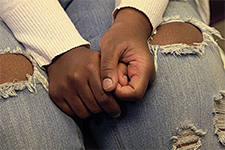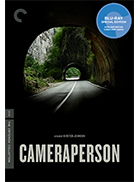Cameraperson
|  Kirsten Johnson’s is not a particularly well-known name, even among those who regularly watch documentaries, the film mode in which she has spent her entire career. However, if you’ve seen any important documentary films over the past two decades, you have likely seen her work on screen. Most recently she was the lead cinematographer on Citizenfour (2014), Laura Poitras’s Oscar winner about Edward Snowden; The Invisible War (2012), Kirby Dick’s Oscar-nominated look at rape culture within the military; and Darfur Now (2007), Ted Braun’s searing look at genocide in Sudan. She has also worked as a camera operator on numerous other films, including Ted Demme and Richard LaGravenese’s A Decade Under the Influence (2003), Michael Moore’s Fahrenheit 9/11 (2004), and several episodes of PBS’s Independent Lens series. She has been all over the world, including some of its most dangerous locations, shooting footage for more than 60 films dating back to late 1990s. Cameraperson is the third documentary feature she has directed herself, the previous two being Innocent Until Proven Guilty (1999) and Deadline (2004). However, unlike those films, Cameraperson is a memoir—a collage film about her work over the past 25 years that is also a love letter of sorts to the power and immediacy of the documentary form. Johnson is simultaneously present in every moment of the film since everything we see was shot with her behind the camera (sometimes we can see her reflection in windows or hear her voice talking about the shot she’s getting) and absent, since the content of the film is not of her directly, but rather what she has recorded over the years. The footage included in the film comes from all over the world—Bosnia, Nigeria, Uganda, Yemen, Afghanistan, and Cuba, as well as numerous locations within the U.S., including Brooklyn, New York, Jasper, Texas, and Huntsville, Alabama—and the tone of the material ranges from the distanced to the intensely personal. While much of the material focuses on “big issues” involving war, political subjugation, and the justice system, other moments are drawn from Johnson’s personal life, including heartbreaking footage of her mother who was diagnosed with Alzheimer’s and is clearly struggling to maintain her identity. Almost all of the footage comes from material shot for, but not used in, two dozen different documentaries; some of it is B-roll—footage of landscapes and people meant to establish a sense of time and place—and some is interview footage. The overall impact is quite fascinating, weaving a wildly varied tapestry that conveys nothing if not the breadth of documentary work. The project originated from Johnson’s felt need to do something with footage she had shot for a never-finished documentary about Afghanistan to be titled A Blind Eye, specifically interviews with a young woman who didn’t want her face to be shown and a teenage boy named Najib who was blinded in one eye by a Taliban rocket. The resulting film is purposefully disjointed, moving us from segment to segment with no obvious connections and no narration or on-screen text aside from location information and a few names to give us context. One could argue that this lack of connecting tissue is part of the film’s strength, as it allows us to take each segment on its own terms, rather than trying to force them into a larger whole beyond their existence as part of Johnson’s body of work. The lack of context also makes some segments even more intriguing, as we gradually learn who we are watching on-screen through what they say in the interview; it allows each segment to unfold on its own terms, rather than in some predetermined sense. However, there is an inherent problem with this design, at least experientially: So many moments from the film are so fascinating in their own right that they make us want to see the entire documentary for which they were shot, rather than moving on to the next segment within the film we’re watching. Cameraperson is, by design, a mosaic that invites you into each individual moment, but only for a brief period of time before forcing you to move on (it is, in Johnson’s own words, “a fragmentary portrait”). That can be somewhat frustrating, because Johnson often holds on a moment just long enough to bring you in—I’m thinking particularly about the interview with the lawyer in Jasper who was prosecuting the white supremacists for the gruesome dragging death of James Byrd, Jr., in the late 1990s and one with a young African American woman in Alabama explaining (with her face off-camera, the lens pointed only at her nervous hands on her jean-clad legs) why she felt the need to have an abortion—and then you’re off to the next segment. Cameraperson is testament to the richness of Johnson’s extensive work and the importance of the documentary form, and in that regard it is a moving, important film in its own right, even though I constantly felt like I was being spun out of it by my desire to see more.
Copyright © 2017 James Kendrick Thoughts? E-mail James Kendrick All images copyright © The Criterion Collection | |||||||||||||||||||||||||||||||
Overall Rating: 

 (3)
(3)


